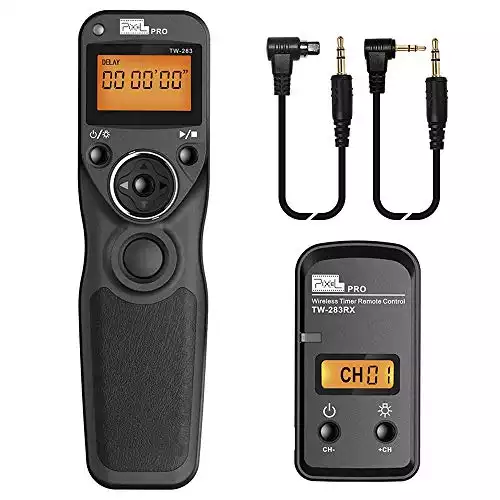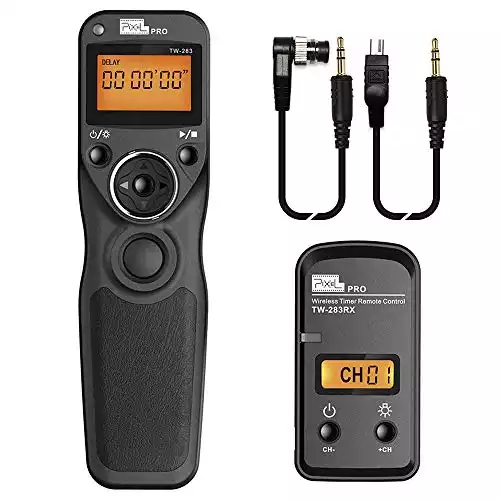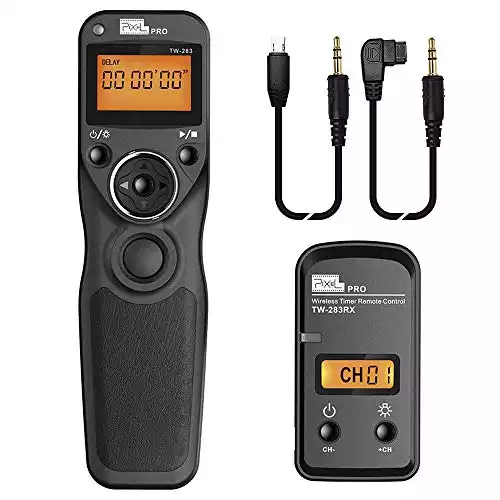Using an intervalometer can be a great and cheap way to give you the remote control of your camera that you need for astrophotography, timelapse photography, self-portraits, and anything else.
We recommend the Pixel TW-283 as the best intervalometer, giving all the control you need for good value. There are different versions depending on your camera’s make and model.
We also suggest some alternative options for Canon, Nikon, and Sony cameras and dig into how to use them to get the most from your camera.
|
Primary Rating:
4.5
|
Primary Rating:
4.5
|
Primary Rating:
4.5
|
|
Make & Model:
Pixel TW-283 E3/N3
|
Make & Model:
Pixel TW-283
|
Make & Model:
Pixel TW-283 S1/S2
|
|
$49.99
|
$49.99
|
$49.99
|
Best Intervalometers
Pixel TW-283 Intervalometer
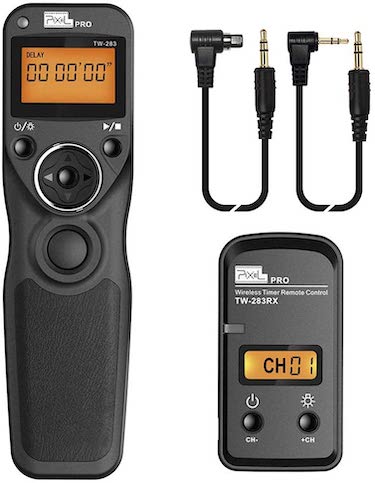
The Pixel TW-283 is the best intervalometer giving you all you need in a programmable remote release and timer for your Canon, Nikon, or Sony camera.
There are a number of different models that work for different cameras:
- Canon: Compatible with Canon’s most popular DSLR and Mirrorless cameras like the 5D and 6D models.
- Nikon: Compatible for most popular Nikon DSLRs like the D850 and D750, as well as the newer Nikon Mirrorless models the Z6 & Z6 II and Z7 & Z7 II.
- Sony: For popular Sony Mirrorless cameras, like the A7S and A7RIV, etc.
You can also find the right model to work with Pentax, Fujifilm, Olympus, and Panasonic cameras. Check the Amazon listing page to see all possible cameras you can use with each version.
It has a number of different modes, including:
- Single-Click Mode: This is for operating your camera remotely and taking one shot at a time. Note, that pressing the button halfway on the transmitter works the same as a half-press on your camera and will activate auto-focus.
- Continuous Mode: Holding the button down will continue to take shots until you release it. Great for trying to capture something fast-moving and then pick out the best shot.
- Bulb Mode: This is to take longer exposures and is operated by pressing the button to start and then again to stop.
- Delay Shooting Mode: Set a delay from pressing the shutter release button and program the number of shots to take. The delay can be anything from 1 to 59 seconds, and it can take up to 99 shots in this mode with your selected settings. You’ll probably be using this for astrophotography and timelapse photography, although you may also use the timer-schedule mode.
- Timer-Schedule Mode: Similar to the above, but enables you to program it to shoot with your programmed settings at a certain time. This way you can set your gear up and leave it to shoot without you having to physically press the button.
What we like about the Pixel TW-283:
- Gives you all you need in an intervalometer or remote shutter release in terms of programmability.
- Menus are easy to navigate and program. Definitely easier to figure out than my Nikon’s internal intervalometer!
- Good battery life. Switches off on its own, so won’t drain itself down if accidentally switched on whilst in a bag.
- Can be used with a simple, direct wired connection. Just make sure you get the right cable with it when buying.
- Can also be used with a wireless remote connection. This is a 2.4GHz wireless control system and the manufacturer says it should work from over 80 meters away (although we haven’t tested it that far).
- One model can be used with multiple cameras as long as you have the correct adapter.
- Can set it to different channels if someone else you are with is using the same intervalometer. This avoids any interference and can be handy if you are out shooting with a friend and they happen to have this same bit of kit.
- Works in the cold. Important for astrophotographers who are out in the night and have sometimes found limitations in their gear caused by low temperatures.
If there are any grumbles about this tool, it’s just that it can’t be turned off – instead, it shuts off on its own when not used for a while. This hasn’t proved a problem for me as the battery life has persisted for a long time despite this. Also, this can be a bonus as you don’t want any of your gear to drain its batteries by accidentally being knocked on in your camera bag.
It features two main components – a transmitter and a receiver. The receiver needs to be attached to the camera when using it wirelessly.
All in all, this is a great intervalometer that can be found for most cameras out there on the market. Check the buttons below for the most popular options.
Note that with some packages it is sold with multiple cables – for example, the DC0 for Nikon vs the DC0/DC2 for Nikon, or the S1 vs S2 for Sony. If you don’t need this you may be able to save yourself a little money by choosing the cheaper option as this is the only difference (just check which version is compatible with your camera model).
Intervalometers & Astrophotography

For astrophotography, an intervalometer is an essential part of your gear setup.
Your camera may have an internal intervalometer (see more on this below), but these are usually fairly hard to navigate compared to the best models recommended in this article. They also give you that remote control so you can click the shutter release button without putting vibrations through your camera and ruining your image from the very start.
The main reason why using an intervalometer is important for astrophotography is that a common technique for shooting the stars and deep-sky objects is to take multiple long-exposure pictures of the same composition in succession. You can then “stack” the photos in post-production and combine them to create one single (much better) image.
This is important since you are capturing images of faint objects in low light and you are limited in how long you can have your exposure time as after a certain amount of time the stars will start to trail and lose their sharpness.
Intervalometers & Time Lapse Photography
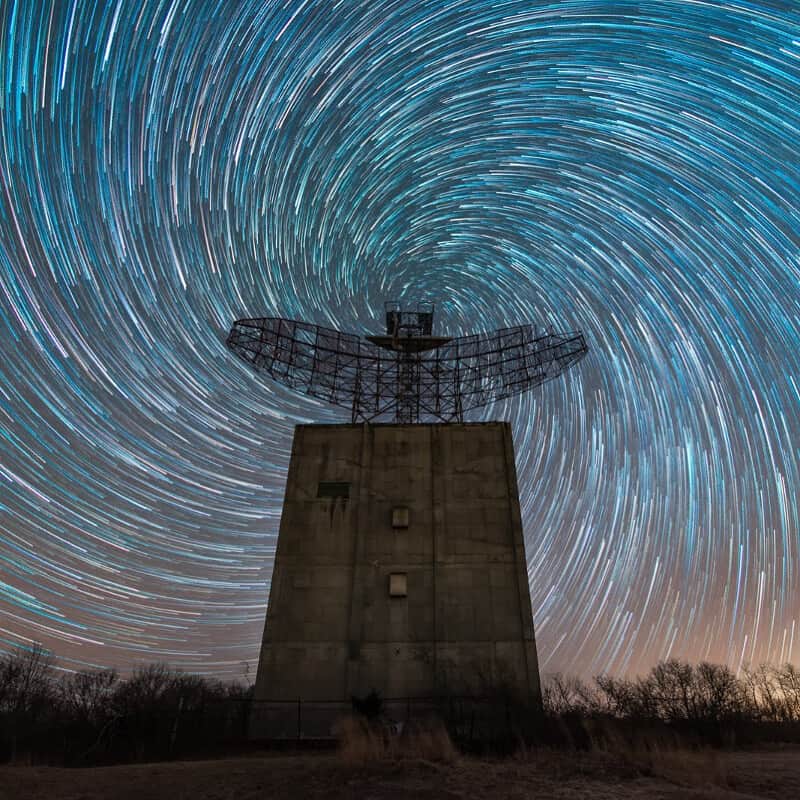
Intervalometers are also extremely useful for timelapse photography.
With this, you can either create an individual image, like that above of star trails or produce a video clip made up of multiple individual images.
The custom programmability from the intervalometer will enable either to be done.
You can even create astrophotography time-lapse clips. Here’s a great video from a friend of Skies & Scopes Michael Ver Spill (“Milky Way Mike”) on how he used an external intervalometer to do just this:
Cameras with Intervalometers
Many cameras have intervalometers in-built and you may prefer to take advantage of this over buying a new external piece of gear.
The best list I can find of cameras with built-in intervalometers is this on the Lonely Speck website. It is from this where we have got this info below and full credit to them for attempting to keep it up-to-date:
Canon cameras with intervalometers
- R5
- R6
- 7D Mark II
- 1100D
- 500D
- 50D
- 550D
- 5DS/R
- 5D Mark II
- 5D Mark III
- 5D Mark IV
- 80D
- 600D
- 60D
- 650D
- 6D
- 6D Mark II
- 700D
- 7D
- EOS M
Nikon cameras with intervalometers
- D200
- D300
- D300s
- D3
- D3s
- D3x
- D4
- D4s
- D5000
- D5100
- D5200
- D5300
- D5500
- D5600
- D500
- D600
- D610
- D700
- D750
- D780
- D7000
- D7100
- D7200
- D7500
- D750
- D800
- D800E
- D810
- D810A
- D850
- Z6
- Z6 II
- Z7
- Z7 II
- Z5
- Z50
Sony cameras with intervalometers
- NEX-5R
- NEX-5T
- NEX-6
- a5000
- a5100
- a6000
- a6100
- a6300
- a6400
- a6500
- a6600
- a7
- a7II
- a7III
- a7R
- a7RII
- a7RIII
- a7RIV
- a7S
- a7SII
- a7SIII
- a9
- a9II RX1
- RX1R
- RX1RII
- RX100M3
- RX100M4
- RX100M5
- RX100M7
- ZV-1
Intervalometer vs Remote Shutter Release
The difference between an intervalometer and a remote shutter release is that a remote shutter release is literally just a handheld remote control for activating the shutter release button to take pictures.
They do not have the capacity to program the camera’s settings via the remote controller.
However, they are cheap and work great if you just want a simple wireless remote to press the button without moving your camera.
How To Use An Intervalometer
For the most part, it will be a matter of exploring the different modes and making it work for whatever photography you are doing.
As noted above, for astrophotography or time-lapse photography you are most likely to be a timer-schedule or delay mode that allows you to program your desired settings for multiple captures and then let it run.
Here’s a good general overview of using an intervalometer:
What are the Best Intervalometer Apps?
One other thing to consider is that there are smartphone apps that you can use to connect to your camera and have control like an intervalometer.
Some of the options are:
- Canon Camera Connect (for Canon cameras)
- Snapbridge (for Nikon cameras)
- Shutter (for Sony cameras)
See also the Best Apps for Astrophotography for more suggestions.
Over to you – What’s the Best Intervalometer for Astrophotography?
Overall then, we recommend the Pixel TW-283 as the best intervalometer for Nikon, Sony, Canon, and other cameras.
It does all you need at a good value price and has multiple versions to work for pretty much any camera.
Alternatively, you could look into using your camera’s internal intervalometer (if it has one) or using one of the apps noted above and operating your DSLR or mirrorless camera from your smartphone.



